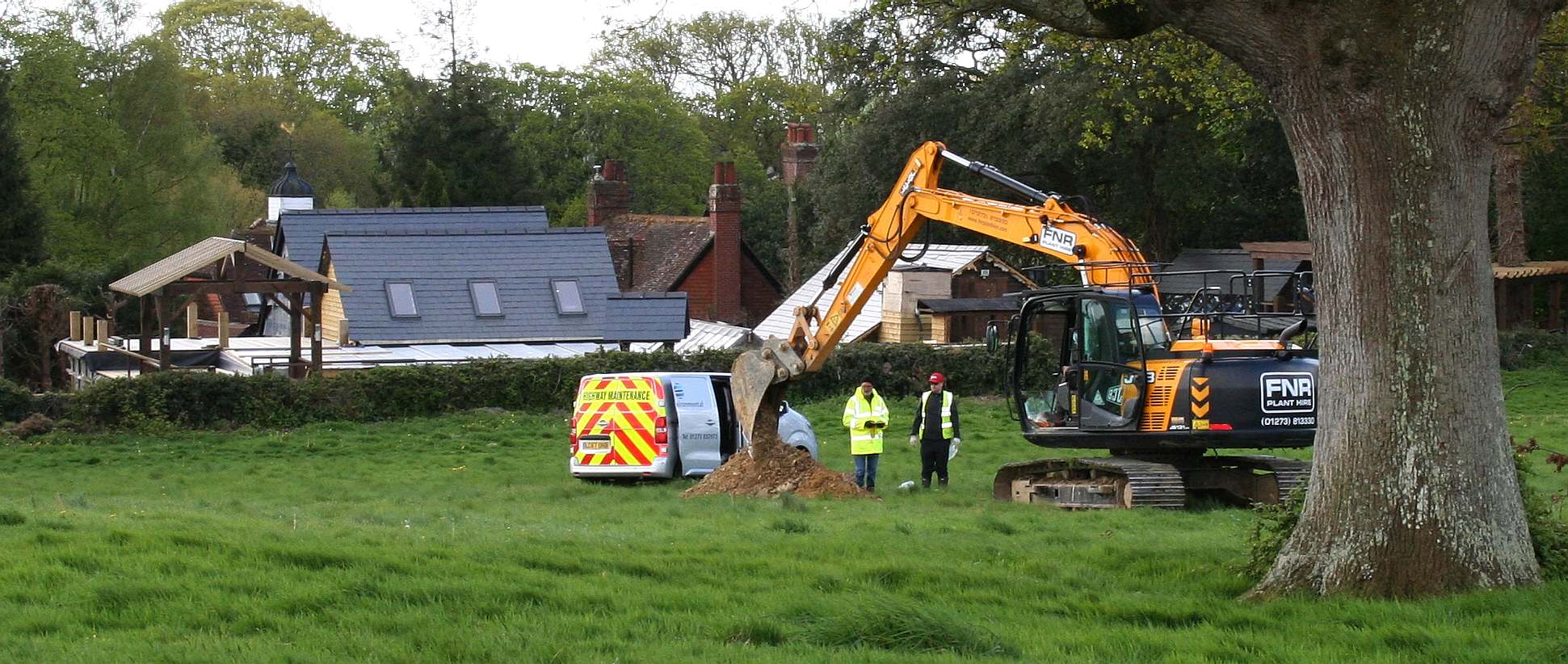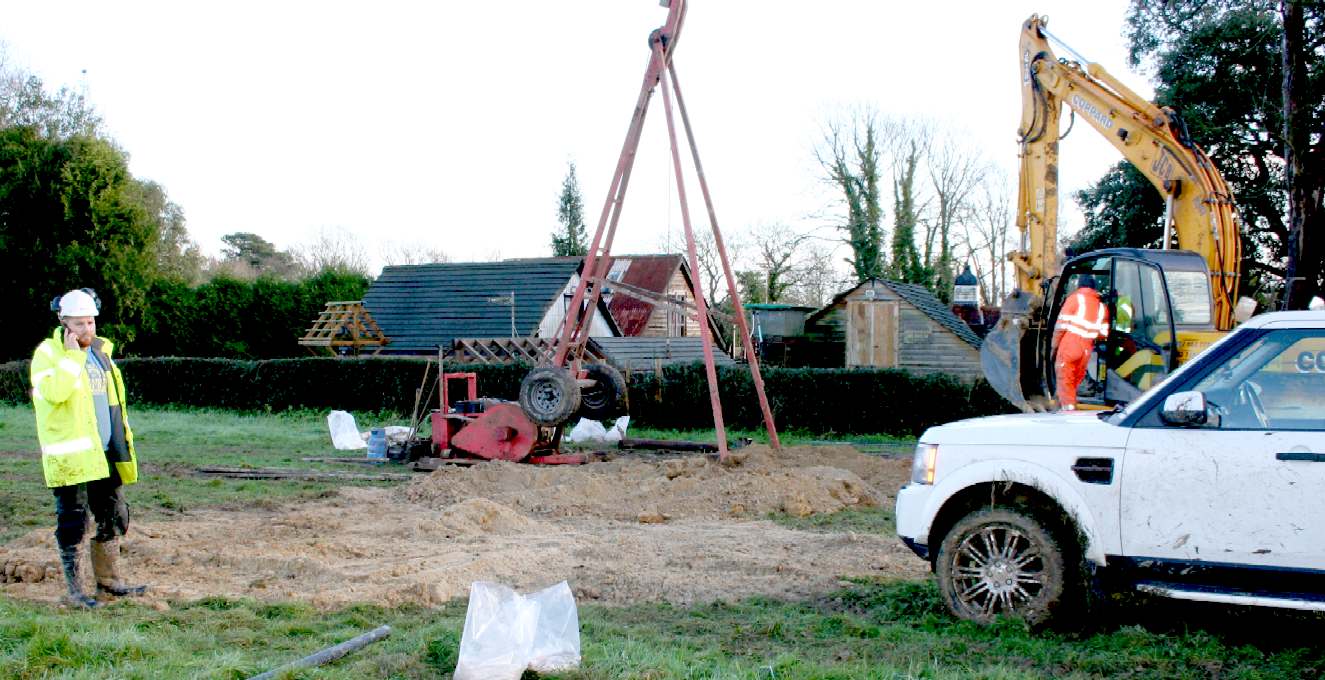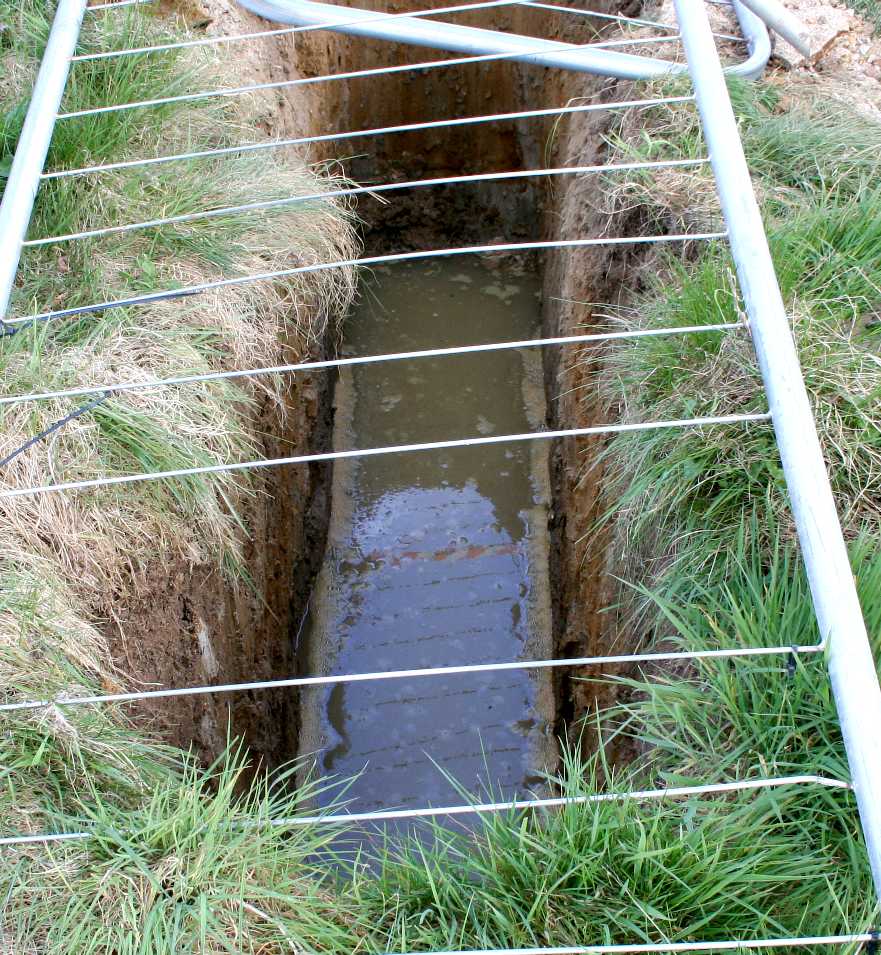|

WATER
RIGHTS - Clarion Housing Group and Thakeham
Homes are in danger of spoiling an ancient well that supplies water
to many concerns in this vicinity. In the picture you can see a hired
digger scooping out trenches to test drainage by pouring in water and
measuring the rate of absorption by the soil. It seems to us that if you
build houses on the ground that feeds the ancient well, that
contamination from garden treatments such as Roundup and engine oils,
etc., will find its way into this well leading to claims against the
owners of the houses who would have been sold a pup, and/or against the
Council for approving the proposal, by way of a negligence claim, and/or
against the vendors or developers. Any way you look at it the developers
and Council concerned should take steps to ensure that no development
takes place until the proper tests and evaluations have been completed,
and after that stage, to ensure that any houses built in this location
will not be on a path that includes the water
table that feeds the ancient well.
Any
failure to conduct the proper tests and house situation, along with safe
sewage disposal, may tempt the Secretary
of State to call in the application. We imagine that all of those
with a financial interest in this piece of greenbelt will want to
resolve issues before it starts to get complicated.
4.
PROMOTING SUSTAINABLE TRANSPORT
29. Transport policies have an important role to play in facilitating sustainable
development but also in contributing to wider sustainability and health objectives. Smarter use of technologies can reduce the need to travel. The
transport system needs to be balanced in favour of sustainable transport
modes, giving people a real choice about how they travel. However, the Government recognises that different policies and measures will be required
in different communities and opportunities to maximise sustainable transport
solutions will vary from urban to rural areas.
30. Encouragement should be given to solutions which support reductions in
greenhouse gas emissions and reduce congestion. In preparing Local Plans,
local planning authorities should therefore support a pattern of development
which, where reasonable to do so, facilitates the use of sustainable modes of
transport.
31. Local authorities should work with neighbouring authorities and transport
providers to develop strategies for the provision of viable infrastructure
necessary to support sustainable development, including large scale facilities
such as rail freight interchanges, roadside facilities for motorists or transport
investment necessary to support strategies for the growth of ports, airports
or other major generators of travel demand in their areas. The primary function of roadside facilities for motorists should be to support the safety
and welfare of the road user.
32. All developments that generate significant amounts of movement should be
supported by a Transport Statement or Transport Assessment. Plans and decisions should take account of whether:
●● the opportunities for sustainable transport modes have been taken up
depending on the nature and location of the site, to reduce the need for
major transport infrastructure;
●● safe and suitable access to the site can be achieved for all people; and
●● improvements can be undertaken within the transport network that cost
effectively limit the significant impacts of the development. Development
should only be prevented or refused on transport grounds where the residual cumulative impacts of development are severe.
33. When planning for ports, airports and airfields that are not subject to a
separate national policy statement, plans should take account of their growth
and role in serving business, leisure, training and emergency service needs.
Plans should take account of this Framework as well as the principles set out
in the relevant national policy statements and the Government Framework for UK Aviation.
34. Plans and decisions should ensure developments that generate significant
movement are located where the need to travel will be minimised and the use of sustainable transport modes can be maximised. However this needs to
take account of policies set out elsewhere in this Framework, particularly in
rural areas.
35. Plans should protect and exploit opportunities for the use of sustainable
transport modes for the movement of goods or people. Therefore, developments should be located and designed where
practical to
●● accommodate the efficient delivery of goods and supplies;
●● give priority to pedestrian and cycle movements, and have access to high
quality public transport facilities;
●● create safe and secure layouts which minimise conflicts between traffic
and cyclists or pedestrians, avoiding street clutter and where appropriate
establishing home zones;
●● incorporate facilities for charging plug-in and other ultra-low emission
vehicles; and
●● consider the needs of people with disabilities by all modes of
transport
36. A key tool to facilitate this will be a Travel Plan. All developments which
generate significant amounts of movement should be required to provide a
Travel Plan.
37. Planning policies should aim for a balance of land uses within their area so
that people can be encouraged to minimise journey lengths for employment,
shopping, leisure, education and other activities.
38. For larger scale residential developments in particular, planning policies
should promote a mix of uses in order to provide opportunities to undertake
day-to-day activities including work on site. Where practical, particularly
within large-scale developments, key facilities such as primary schools and
local shops should be located within walking distance of most properties.
39. If setting local parking standards for residential and non-residential
development, local planning authorities should take into account:
●● the accessibility of the development;
●● the type, mix and use of development;
●● the availability of and opportunities for public transport;
●● local car ownership levels; and
●● an overall need to reduce the use of high-emission vehicles.
40. Local authorities should seek to improve the quality of parking in town
centres so that it is convenient, safe and secure, including appropriate
provision for motorcycles. They should set appropriate parking charges that
do not undermine the vitality of town centres. Parking enforcement should
be proportionate.
41. Local planning authorities should identify and protect, where there is robust
evidence, sites and routes which could be critical in developing infrastructure
to widen transport choice.
CONTACTS
Department for Communities and Local Government
Eland House
Bressenden Place
London,
SW1E 5DU
United
Kingdom
Telephone: 030 3444 0000

HINKLEY,
CALIFORNIA - GROUND WATER CONTAMINATION - The
town of Hinkley, California,
located in the Mojave Desert, (about 121 miles driving distance
north-northeast of Los Angeles) had its groundwater contaminated with
hexavalent chromium starting in 1952, resulting in a legal case
against Pacific Gas & Electric (PG&E) and a multimillion-dollar
settlement in 1996. The legal case was dramatized in the film Erin
Brockovich, released in 2000.
Residents of Hinkley filed a class action against PG&E,
encaptioned Anderson, et al. v. Pacific Gas and Electric (Superior Ct.
for County of San Bernardino, Barstow Division, file BCV 00300.
In 1993, Erin Brockovich, a legal clerk to lawyer Edward L. Masry,
investigated the apparent elevated cluster of illnesses in the
community linked to hexavalent chromium. The efforts of Brockovich and
Masry, and the plight of the people of Hinkley, became widely known
when the film Erin Brockovich was released in 2000.


After
many arguments, the case was referred to arbitration with maximum
damages of $400 million. After the arbitration for the first 40 people
resulted in roughly $110 million,
PG&E reassessed its position and decided to end arbitration and
settle the entire case. The case was settled in 1996 for $333 million,
the largest settlement ever paid in a direct-action lawsuit in U.S.
history.
In 2006, PG&E agreed to pay $295 million to settle cases involving
another 1,100 people statewide for hexavalent chromium-related claims.
In 2008, PG&E
settled the last of the cases involved with the Hinkley claims for $20
million.
LEAD
CASE: In the case of Wealden
District Council and planning application WD/2015/0090/MAO,
originally filed by Tim
Watson in 2014, then re-filed by Gleeson
Developments in 2015, and taken over by Clarion
Group and Thakeham
Group, there appear to be multiple errors in applying these
policies to greenbelt, including failing to protect open spaces and
the historic built environment, and not promoting sustainable
transport.
The
Horse
Sanctuary Trust are following this case with much interest. We
consider that the paper trail will eventually make interesting
reading, leading us to who is making the decisions and the money
........

GREENBELT
- Digging up Greenfield sites for quick
profits from windfall planning consents is ruining the heritage of
the nation. Once it is gone, it is gone. Britain is short of genuinely
affordable housing that developers are loath to provide where all they
want is the money. It may be that Clarion Housing and Thakeham intend
building affordable units on this site. They should also bear in mind
the requirement for sustainable development in United
Nations terms. Copyright photograph © April 26 2018, Herstmonceux
Museum Limited. All rights reserved. You may not copy this picture
except for educational
use.
|




